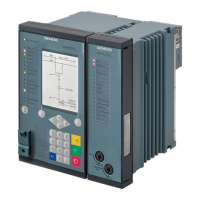The current overtemperature can be obtained from the operational measured values. It is shown in percent.
An indication of 100 % means that the thermal threshold has been reached.
The analysis of the RMS value of the current over a broad frequency band also includes the harmonic compo-
nents. These harmonic components contribute to the temperature rise of the equipment.
Ambient Temperature
This function can take the ambient temperature into consideration The reference temperature of the thermal
model is 40 °C. If the ambient temperature drops below the reference temperature, the thermal limit
increases. The equipment can be stressed more. If the ambient temperature is higher, the conditions change.
The Default temperature parameter can be used to fix or measure the ambient temperature. The
Minimal temperature parameter limits the coupled ambient temperature. If the measured ambient
temperature is lower than the minimum temperature, the minimum temperature is processed in the thermal
model.
The ambient temperature refers to the overtemperature of the protected object, which sets itself at the rated
current (parameter Temperature rise at Irated).
The measured ambient temperature is recorded by an external RTD unit (RTD = Resistance Temperature
Detector) and provided by the functions RTD unit Ether. or RTD unit serial of the function group Analog
units. When using the Temperature sensor parameter, the respective temperature sensor can be selected.
If the temperature measurement is disrupted, for example, due to an open circuit between the device and the
RTD unit, the device will report it. In this case, the process continues with either the temperature measured
last or the value set under the Default temperature parameter, whichever value is the highest.
Current Influence
The thermal replica based on the single-body model applies with limitations to high overcurrent situations
(short circuits). To avoid an overfunction of the overload protection, the thermal replica must be influenced
for overcurrents (exceeding l
limit
). You can select between 2 strategies for this:
•
Freezing of the thermal memory
•
Limitation of the input current for the thermal replica to the set current. The temperature rise is thereby
retarded at high currents.
Warning Thresholds
The thermal warning threshold issues a warning indication before the tripping threshold (tripping tempera-
ture) is reached. In this way, for example, a load can be reduced in sufficient time and a disconnection
avoided. At a normal K-factor of 1.1, a thermal memory value of 83 % sets in at continuously flowing rated
current.
Apart from the thermal warning threshold, the overload protection also has a current-warning threshold. This
current-warning threshold can signal an overload current in sufficient time before the overtemperature value
has reached the warning or tripping threshold.
Dropout of Tripping
Once the thermal memory has fallen below the setting value of the Dropout threshold operate, the trip
command is cancelled upon tripping. In contrast, the current-warning threshold and the thermal warning
threshold are reduced at a fixed dropout threshold (see technical data).
Behavior in the Event of Auxiliary-Voltage Failure
The behavior of the thermal replica can be controlled upon auxiliary-voltage failure via the Storage of
thermal replica parameter. You can save the thermal state for a down time of 500 min. If the supply
voltage returns, the thermal replica continues to function with the saved thermal state.
If the thermal replica is not saved, it will be reset to 0 upon failure of the auxiliary voltage.
Protection and Automation Functions
7.27 Thermal Overload Protection, 1-Phase
SIPROTEC 5, High-Voltage Bay Controller, Manual 895
C53000-G5040-C015-9, Edition 11.2017

